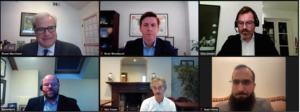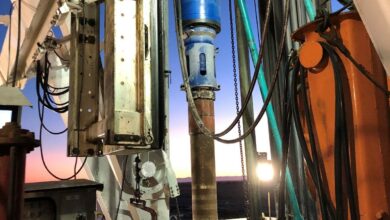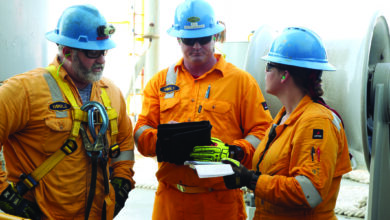Workforce panel: Next-generation talent pursues work with a purpose
Management may need to make ‘bold moves’ to recruit younger workers, retain existing staff by providing more growth opportunities, clear career paths
By Jessica Whiteside, Contributor

When Steven Harris was a young man in Scotland, he saw the crews of rough, tough offshore workers and wanted to be one of them. He joined a deck and drill crew in the North Sea, drawn by the money, the adventure, the engineering, the culture and the mystique of a career in oil and gas that’s taken him around the world from rig crew to risk management leader.
But now, as Head of HSSE for Vysus Group, he’s not seeing the sector that held such appeal for his younger self exert the same pull on young talent launching their careers today.
“Ironically enough, the reputation and perception of the industry that drew me in is now the reputation and perception that has turned people away,” Mr Harris said during a panel discussion on employee recruitment, development and retention at the 2020 IADC World Drilling Conference, held virtually on 9 December.
Joining Mr Harris on the panel were Olav Vorup Jensen, Head of People Skills, Maersk Training; Saad Imtiaz, Lead Engineer Field Service, Baker Hughes; Ken Fraser, Founder and Chairman, Norwell. Shane Marchand, Vice President Marketing, Helmerich & Payne, and Brian Woodward, Vice President of Corporate Services at Noble Corp, served as session moderators.
The discussion acknowledged that companies in the drilling space cannot change certain immutable factors that impact their workforce – such as oil prices, boom-bust cycles or what the weather is like offshore. But they shared some insights that could help companies improve employee engagement and move the needle on attracting a fresh pipeline of talent.
Competing against a bad reputation
Mr Harris was blunt in his assessment that oil and gas hasn’t done a great job in selling itself to members of the Millennial generation, whom he says often consider the sector “a social faux pas that they would rather avoid.”
When he meets with university students as a guest lecturer, they don’t ask about the money or perks of a career in oil and gas, he said. But every single one asks about value-related aspects, such as corporate social responsibility, environmental strategies, technological advances and organizational attitudes toward leadership and innovation.
“Millennials are fundamentally drawn to aligning their values with their employer, and I think that aspect is either missed or certainly not emphasized enough in 99% of the organizations during their recruitment process,” Mr Harris said. “There must be so much value being lost at that stage.”
He advised companies to be aware of mega-trends that will be important post-pandemic, such as demographic shifts, the climate crisis, hyperconnectivity, the health revolution and diversity. They should also focus on messaging the next generation about how they can make a difference in those areas by working within the industry.
“We’re one of the most technically innovative industries, and if you wanted an opportunity to effect meaningful change in things like the climate crisis, then it is actually within the oil and gas industry that you place yourself.”
Mr Jensen said young people are seeking a purpose in what they do – which means companies need to provide a clear purpose and an appealing opportunity if they want to attract smart people to the business.
He described Maersk’s efforts to establish an employee value proposition around the message of being global, having a history, making a difference in the world and unlocking people’s potential by offering stretching assignments, or tasks that go beyond the employee’s current knowledge or skill level. Not many years ago, he said, the company thought that its name and success were enough to draw new workers. Then it realized that young people saw the company as a “has-been” workplace.
“The only way to improve was to face the challenge and work thoroughly and professionally with who we are, what we do, why we do it, and what we can offer. And then we have to take some bold moves,” Mr Jensen said. “You don’t change a culture with a fancy job ad. You change it by actually taking some bold moves.”
Encouraging offshore education
One bold move Mr Fraser suggested companies consider is helping rig workers attain university degrees or other credentials while working offshore to prepare them for future careers off the rig. While that may seem counterintuitive to retention, it could be a tool for both employee engagement and recruitment.
To see what makes a happy rig (and, therefore, a safe and productive rig), Mr Fraser surveyed online comments from oil and gas workers about what they liked and didn’t like about life offshore. One of their top dislikes was poor career prospects. When the traditional career path is to enter as roustabout and work your way up to toolpusher, there are simply not enough senior positions for everyone who wants one. Mr Fraser shared a typical staff pyramid with six roustabouts at the bottom but only one toolpusher at the top.
“So, five people – if they have any ambition – are sadly going to be disappointed,” he said.
With distance learning readily available today and with good internet facilities on the rigs, it’s becoming easier to complete a degree while working offshore.
Mr Fraser estimated that with a couple of hours of study a day, a worker could complete a degree online and offshore in about five years. When they finish, they will be ready for a new career off the rig – armed not only with a degree but with the valuable competencies that come with rig experience, including management of change, safety and people skills.
“We have the available facilities to give people a chance to study for other things,” Mr Fraser said, suggesting this approach could help prepare rig workers for other roles within the drilling contractor’s own organization.
“There’s an HR department there, there’s a contracts department, there’s supply chain management, there’s purchasing,” he said. “There are several roles that need graduates and could be filled by encouraging some of the candidates who may not be ideal for the toolpusher’s job.”
Mapping training and development
One area of employee development in which the oil and gas sector excels is in identifying training and competency requirements according to roles and responsibilities. Mr Jensen said he was amazed when he first began working in the sector to see how structured companies were in this regard. However, “this strategic link between the training matrixes and where the companies are going, I think that is definitely something that could be improved,” he cautioned.
For employees to remain engaged, they need to have a clear career path ahead of them that includes clear objectives about what they need to achieve in their current position, Mr Imtiaz said.
“A nice way to disengage an employee is to put him in a role without an objective for a long time.”
He outlined a “zoomed in and zoomed out” approach to managing the development of an employee’s career in which the young professional alternates between broad-based roles that help them understand the holistic picture and specialized roles that help them gain subject matter expertise. By zooming in and out between these different perspectives, the employee builds the knowledge and experience they will need to eventually train the incoming workforce and develop strategy for the company.
He recommended that the “zoomed in,” or specialized portions, of a young professional’s career include data analytics responsibilities. Whatever their field of specialty, they should learn how to apply data science models and come up with recommendations. Developing an employee’s expertise in this rapidly evolving field not only benefits the company but also makes the employee feel relevant – an important component of job satisfaction, said Mr Imtiaz.
He encouraged companies to view this dynamic approach to employee development as a win-win for both employer and employee, even if that carefully cultivated worker gets hired away by the competition. If you invest in this level of employee development, whenever a problem comes up for your company, he said, “you’ll have a room filled with much more dynamic individuals to look for solutions.”
Making the business case for engagement
Employee engagement is about drawing a deeper commitment from your employees. To do this, they need to feel they’re included in the team, Mr Harris said.
That means providing clear goals so employees understand their role and where they fit in with the organization’s purpose and objectives. It means empowering employees to offer ideas and express their views. It means ensuring regular and constructive feedback, and demonstrating strong and authentic values within the organization. When a company can do all that, he said, they’ll see the results in everything from lower accident, grievance and absence rates to higher productivity.
“If we get it right, we have a team, a department, an organization, a rig where everyone wakes up and says, ‘Great, I’m going to work, I know what I’m going to do today, I’ve got some great ideas, I can’t wait to try them out, and I’m looking forward to seeing the team,’ as opposed to a crew that wakes up and says, ‘I’ve only got two more boat drills before I’m going home.’ Nobody wants that.” DC



